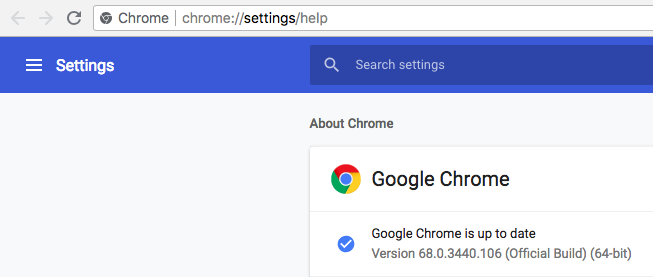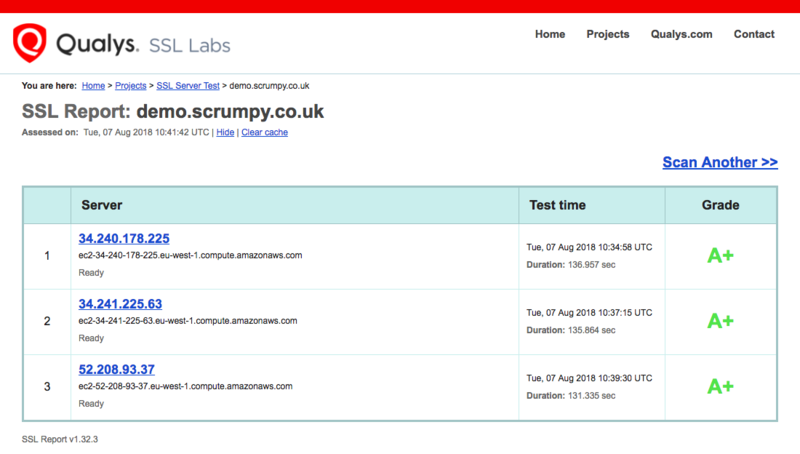
The technology used behind and on the internet is constantly evolving. If you still want to be found and viewed on it - you have to keep up. Burying your head in the sand isn’t an option.
Established more than 20 years ago, it’s hard to imagine a time before Google’s dominance of the online world. They have embedded themselves into everyday language, with the term ‘Google’ commonly being used as a verb in its own right and even being added to the Oxford English Dictionary. As one of the worlds biggest names, you can’t deny the power and influence they have on the masses and in turn how their technology is used.
Owning an impressive portfolio that spans several sectors, Google are best known for their internet services. Their market share is unrivalled, boasting the planets most used web browser, search engine, map and mobile operating system.
Chrome 68 update
As the world’s most popular way of accessing the web, Google’s web browser Chrome makes up for almost 60% of the internet’s users. With its most recent update to version 68, anyone using Chrome will have noticed it now identifies a website as either ‘Secure’ or ‘Not Secure’.
If you are to look at the top left of this web page you will notice a small green padlock and (if using Chrome) the word ‘Secure’. This means that the website you are currently viewing is safe, with the information you view and data you input protected by encryption.
However if you are on an older site, or one that hasn’t been configured to the latest requirements, it will display ‘Not Secure’ and the message: “Your connection to this site is not secure. You should not enter any sensitive information on this site (for example, passwords or credit cards), because it could be stolen by attackers.”
Website security
Historically it has only been considered necessary for a website that handles personal or payment details to be secure; such as online banking and e-commerce sites, where sensitive payment information may be added or stored. In contrast, a brochure type website hasn’t traditionally required such measures as they generally don’t manage any data that could pose a risk.
Whilst this is still mostly the case, new methods of hacking can even compromise a user from just browsing, as opposed to entering details on a website. This could be from using a publically shared internet connection at a cafe for example. As a lot of the internet is still unprotected and vulnerable, data that is transmitted over an unencrypted line can be intercepted, where malicious individuals can eavesdrop and collect or alter data.

Switch to a safer internet
Opting to use newer technologies can help to eliminate security threats. Google has been slowly encouraging businesses and web developers to use encryption for all sites for quite some time now. In 2014 they released a statement and instructional video promoting their mission to make the web safer for everyone with ‘HTTPS Everywhere’. Click here to view the video.
As part of Google’s mission to make the web a safer place, they have strongly encouraged all websites to adopt https. (You can check if a site is using this by looking at the URL of a website, with the part preceding the www.) If a website uses https, the secure version of http, in conjunction with SSL (secure sockets layer) and/or TLS (transport layer security) then the data is secure. Essentially, this process ensures that what is being sent to and fro, both starts and ends at trusted points, with no potential for a malicious individual to intercept in the middle. It also prevents actors falsely impersonating a website.
The use of SSL creates a safe environment for both the user and owner of a site. It’s also worth noting that Google rewards those who use it, by giving higher search rankings as opposed to sites without.
How does this affect me?
Well for starters, make sure you have updated your browser. Programmes update themselves to remove bugs and errors, but also to improve safety. Although having focussed heavily on Chrome, other browsers such as Safari and Firefox, still show whether a website has a valid certificate, and whether it is protected - just with different variations of the padlock symbol. You can also force your browser to change to https, by simply adding a 's' to the standard 'http' to check.

As a business owner, who’s revenue depends on attracting new and reassuring existing customers, it would be naive not to comply to recent requirements. Having those magic words ‘Secure’ reinforce trust and assure a visitor that they should have no concerns whilst using your site. If your computer warned you when visiting a site that it was ‘Not Secure’, would you not think twice before proceeding?
SCRUMPY
I’m sure it’ll come as no surprise that we take security seriously. Add in that we are always striving to be at the forefront of technology, means that all SCRUMPY websites come with the best possible protection, as standard. Regardless whether you have one of our free Lite sites or are a large agency with hundreds of properties, each of our customer's safety is as important as the next.
But don’t just take our word for it. The industries leading test facility, https://www.ssllabs.com/, offer free comprehensive checks for websites. By simply entering in a URL, they run a multitude of scans, to examine potential flaws in a site's security. Take a look at our demonstration site for instance, which scores the highest possible A*

If you are concerned that your website is dated and is at risk of being left behind, then don’t hesitate to get in touch. We are a friendly team of real people who know a thing or two about the property industry and how to keep up with the internet.

